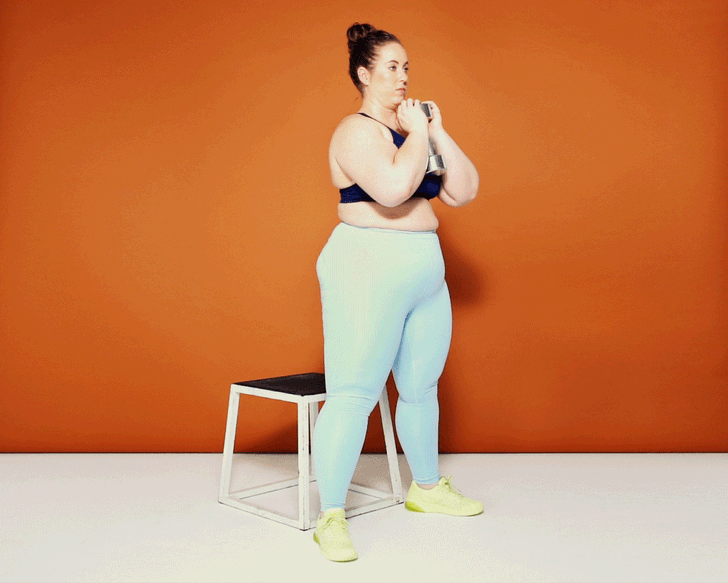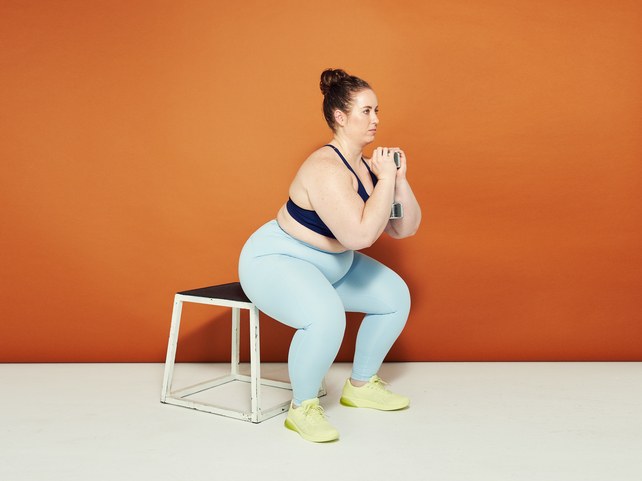Lifting weights doesn’t have to be complicated.
Lifting weights for the first time can be a really intimidating prospect. There’s a seemingly endless list of strength-training exercises you can do, and often, trainers we follow on Instagram like to demo impressive, fancy moves that seem totally impossible to do if you’re picking up dumbbells for the first time. (Even if you’re not a beginner, some of those complicated exercises can make your head spin.) But lifting weights doesn’t need to be complicated—in fact, mastering the simplest, most straightforward moves is all you need to do to establish a really solid, effective routine.
To help you do that, Jason Pak, NASM-certified personal trainer, USA Weightlifting certified sports performance coach, and co-founder of Achieve Fitness Boston, created the below total-body workout specifically for beginner weight lifters. It hits all your major muscle groups in just five moves. “When putting together a total-body workout, the goal is to incorporate as many muscle groups as possible in as few moves as possible by utilizing compound exercises,” Pak tells SELF.
Compound exercises are simply exercises that work more than one muscle group at once, which makes them really efficient. They’re also functional—meaning, “they closely resemble movements that a person might experience in everyday life,” Pak says. “Exercises that incorporate squatting, pushing, pulling, balancing, and stabilizing all challenge the body in very natural, functional ways.” By training these types of movements in the weight room, you’ll be able to efficiently build strength that translates to every aspect of your life.
It’s important to always start slow, and focus on proper form above all else. If you’re unsure if you’re doing an exercise right, consult a trainer, and if an exercise ever causes you pain, stop doing it. Before starting this or any other new exercise program, it’s always a good idea to consult with your doctor to make sure that the exercises are safe for you.
Ready to get lifting? Below, you’ll find details from Pak on how the workout is set up, followed by a demonstration of each exercise by Rachel Denis, a powerlifter who competes with USA Powerlifting and holds multiple New York state powerlifting records.
Moves
- Goblet Squat to Box
- Three-Point Row
- One-Dumbbell Suitcase Lunge
- Single-Arm Floor Press
- Supine Marching
Directions
Start with 3 sets of 8 reps of each exercise. Rest 60 to 90 seconds between each set, and up to 60 seconds between each exercise as needed.
When you feel comfortable with the moves, progress to 3 sets of 10 reps with the same weight. Then, to 3 sets of 12 reps with the same weight. When you are ready, increase your weight by about 5 pounds and go back to 3 sets of 8.
Start with a weight that feels like you’re giving an effort of 7 out of 10 (on a scale of 1 to 10), says Pak. “This serves as a sweet spot where the weight challenges you, but doesn’t make it so difficult that form becomes compromised.”
Here’s how to do each move:

Goblet Squat to Box
“We love goblet squats because they make learning the squat really simple!” says Pak. “Because the weight is out in front of you and close to your center of mass, it makes it easier to descend down and maintain proper spinal alignment.” Pak adds that the box is a great reminder to make sure you sit back, and that you hit the same depth with each rep. “You want to try to squat as low as you can while maintaining a flat back, so make sure to pick an appropriately sized box or surface.” The squatting movement targets your glutes, quads, and core.
- Hold a dumbbell at your chest, with both hands gripping one end.
- Stand in front of a box or bench with your feet about shoulder-width apart, toes slightly turned out.
- Bend your knees and push your hips back as you lower down into a squat and lightly touch your butt on the box. “Your knees shouldn’t travel too far forward (if at all) and your weight should be more toward your heels,” Pak says, to better activate your glutes and hamstrings.
- Drive through your heels to return to standing and squeeze your glutes at the top. That’s 1 rep.
- Do 3 sets of 8 reps.
Three-Point Row
“The three-point row works the pulling pattern and helps to target your mid and upper back,” Pak says.
- Stand with both feet firmly planted on the floor in a staggered stance. Hold a dumbbell in one hand.
- Lean forward and place your other hand on a box or bench. Keep your back flat and engage your core.
- Lift the weight toward your chest, keeping your elbow close to your body. “Make sure that your elbow only goes slightly past your body,” Pak advises. “If it travels any further than that, your shoulder has a tendency to compensate and round forward.”
- Extend your arm back out. That’s 1 rep.
- Do 3 sets of 8 reps, then repeat with the other arm.
One-Dumbbell Suitcase Reverse Lunge
This exercise lets you practice the lunging movement, and works your quads and glutes (and sneakily, your core). “Holding one dumbbell off to one side challenges your core and balance throughout the motion, because you’re working to stabilize your body while you move dynamically through space,” says Pak.
- Hold a dumbbell with your right hand and stand tall with your feet together.
- Step your right foot back and lightly tap your knee on the floor. “Ideally, the angle of your knees in both legs when you’re at the bottom position is about 90 degrees,” says Pak.
- Pause for a beat, and then push through your left foot to return to the starting position. That’s 1 rep.
- Do 3 sets of 8 reps. Then repeat with your left leg, holding the weight in your left hand.
Single-Arm Floor Press
This exercise works on the pushing movement pattern, and works your chest, shoulders, and triceps. “We love the single-arm floor press because it really helps you to understand how to press a weight in a very ‘safe’ environment,” Pak says. “The floor limits your range of motion a bit, and also gives you feedback to press your shoulder blade down and back against. When your shoulder blade isn’t set down and back when pressing a weight, it typically leads to your shoulder rounding forward in a vulnerable position.”
- Lie on your back with your knees bent and feet flat on the floor.
- Hold a dumbbell in one hand, and extend your arm toward the ceiling. Your knuckles should be facing the ceiling, palm facing away from your head.
- Slowly lower your elbow to about 45 degrees from your side. Make sure your shoulder blade is pressing down into the floor.
- Press the weight back up, straightening your arm completely at the top. This is 1 rep.
- Do 3 sets of 8 reps. Then, repeat on the other arm.
Supine Marching
This marching exercise is great for working on core stability, says Pak. Improving core stability is especially important if you’re going to be lifting weights, because it will help you better control your body and do exercises with proper form.
- Lie face up with your knees bent, feet flat on the floor.
- To properly engage your core, place your hands on your ribcage and arch your lower back toward the ceiling while keeping your hips on the ground. Then, do the opposite, and push your ribcage and lower back toward the ground, engaging your core muscles. This is the feeling you want to maintain the entire time.
- Extend your arms out by your sides and lift your knees up so that they are directly above your hips.
- Keeping your knees bent, slowly lower one heel down toward the floor.
- Bring the foot back, and then repeat with the other leg. That’s 1 rep.
- Do 3 sets of 8 reps. As you do this exercise more often, you can slowly start to extend reach leg further from your body with each stride. “Find the sweet spot where the distance that your leg travels challenges you, but you can still keep your ribcage and lower back on the floor,” says Pak.






Facebook Comments